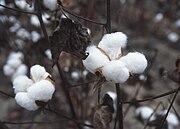
| Cotton |
|---|
 |
| History |
| Terminology |
| Types |
| Production |
| Fabric |
| Part of a series on |
| Clothing and the environment |
|---|
| Environmental impact of fashion |
Cotton recycling is the process of converting cotton fabric into fibers that can be reused into other textile products.[1]
Recycled cotton is primarily made from pre-consumer cotton which is excess textile waste from clothing production.[1] It is less commonly made from post-consumer cotton which is discarded textile waste from consumers such as second hand clothing.[1] The recycling process includes assessing the quality of cotton fibers through systematics collection, manually sorting the materials, and undergoing a mechanical or chemical process to break down the textile fabric into reusable fibers.[2] In the mechanical process, fabrics are torn into individual fibers through a machine, and in the chemical process, the fabrics's chemical properties are broken down through chemical reaction processes such as Lyocell process and dissolution in ionic liquids.[3][4] The mechanical process is the primary way to recycle textiles because the chemical process is not commercially used.[5]
Recycled cotton is less durable than virgin cotton due to the shorter length of recycled cotton fibers which result from mechanical recycling. As a result, recycled cotton requires the addition of additional materials such as polyester to improve durability.[3] Therefore, recycled cotton is often used in products that do not require high-quality cotton fibers such as casual clothing and home building materials.[3][6]
Harvesting raw cotton is a resource intensive process that uses a lot of water, energy, and chemicals.[7] Cotton recycling mitigates wastage and can be a more sustainable alternative to disposal because products can be made out of existing textiles instead of raw materials, therefore, reducing the resources required to harvest raw cotton.[7] However, there are costs associated with cotton recycling, such as the risk of problem shifting and the impact of transporting collected materials which could exceed its intended benefits.[8] Researchers and governments are looking for new technologies and industrial management solutions to improve the social impact of the collection processes for recycled cotton.[9]
- ^ a b c "Recycled Cotton". CottonWorks™. Retrieved 2022-04-09.
- ^ Cite error: The named reference
:0was invoked but never defined (see the help page). - ^ a b c Yuksekkaya, Mehmet Emin; Celep, Gizem; Dogan, Gamze; Tercan, Mevlut; Urhan, Basak (2016). "A Comparative Study of Physical Properties of Yarns and Fabrics Produced from Virgin and Recycled Fibers". Journal of Engineered Fibers and Fabrics. 11 (2): 155892501601100. doi:10.1177/155892501601100209. S2CID 42946005.
- ^ Cite error: The named reference
:1was invoked but never defined (see the help page). - ^ Palme, Anna (2016). Recycling of Cotton Textiles: Characterization, Pretreatment, and Purification (Thesis). ProQuest 2394920195.
- ^ Chang, Y.; Chen, H.-L.; Francis, S. (1 March 1999). "Market Applications for Recycled Postconsumer Fibers". Family and Consumer Sciences Research Journal. 27 (3): 320–340. doi:10.1177/1077727X9902700303.
- ^ a b Cite error: The named reference
:7was invoked but never defined (see the help page). - ^ Sandin, Gustav; Peters, Greg M. (May 2018). "Environmental impact of textile reuse and recycling – A review". Journal of Cleaner Production. 184: 353–365. doi:10.1016/j.jclepro.2018.02.266.
- ^ Press, Frank (1978). "Toward New National Policies To Increase Industrial Innovation". Research Management. 21 (4): 10–13. doi:10.1080/00345334.1978.11756485.
© MMXXIII Rich X Search. We shall prevail. All rights reserved. Rich X Search
